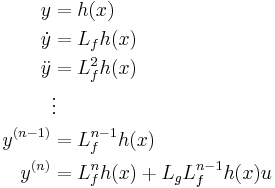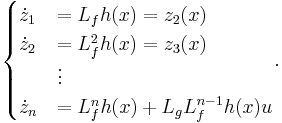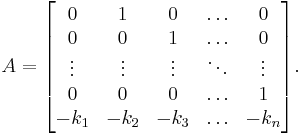Feedback linearization
Feedback linearization is a common approach used in controlling nonlinear systems. The approach involves coming up with a transformation of the nonlinear system into an equivalent linear system through a change of variables and a suitable control input. Feedback linearization may be applied to nonlinear systems of the form
where  is the state vector,
is the state vector,  is the vector of inputs, and
is the vector of inputs, and  is the vector of outputs. The goal is to develop a control input
is the vector of outputs. The goal is to develop a control input
that renders a linear input–output map between the new input  and the output. An outer-loop control strategy for the resulting linear control system can then be applied.
and the output. An outer-loop control strategy for the resulting linear control system can then be applied.
Contents |
Feedback Linearization of SISO Systems
Here, we consider the case of feedback linearization of a single-input single-output (SISO) system. Similar results can be extended to multiple-input multiple-output (MIMO) systems. In this case,  and
and  . We wish to find a coordinate transformation
. We wish to find a coordinate transformation  that transforms our system (1) into the so-called normal form which will reveal a feedback law of the form
that transforms our system (1) into the so-called normal form which will reveal a feedback law of the form
that will render a linear input–output map from the new input  to the output
to the output  . To ensure that the transformed system is an equivalent representation of the original system, the transformation must be a diffeomorphism. That is, the transformation must not only be invertible (i.e., bijective), but both the transformation and its inverse must be smooth so that differentiability in the original coordinate system is preserved in the new coordinate system. In practice, the transformation can be only locally diffeomorphic, but the linearization results only hold in this smaller region.
. To ensure that the transformed system is an equivalent representation of the original system, the transformation must be a diffeomorphism. That is, the transformation must not only be invertible (i.e., bijective), but both the transformation and its inverse must be smooth so that differentiability in the original coordinate system is preserved in the new coordinate system. In practice, the transformation can be only locally diffeomorphic, but the linearization results only hold in this smaller region.
We require several tools before we can solve this problem.
Lie derivative
The goal of feedback linearization is to produce a transformed system whose states are the output  and its first
and its first  derivatives. To understand the structure of this target system, we use the Lie derivative. Consider the time derivative of (2), which we can compute using the chain rule,
derivatives. To understand the structure of this target system, we use the Lie derivative. Consider the time derivative of (2), which we can compute using the chain rule,
Now we can define the Lie derivative of  along
along  as,
as,
and similarly, the Lie derivative of  along
along  as,
as,
With this new notation, we may express  as,
as,
Note that the notation of Lie derivatives is convenient when we take multiple derivatives with respect to either the same vector field, or a different one. For example,
and
Relative degree
In our feedback linearized system made up of a state vector of the output  and its first
and its first  derivatives, we must understand how the input
derivatives, we must understand how the input  enters the system. To do this, we introduce the notion of relative degree. Our system given by (1) and (2) is said to have relative degree
enters the system. To do this, we introduce the notion of relative degree. Our system given by (1) and (2) is said to have relative degree  at a point
at a point  if,
if,
 in a neighbourhood of
in a neighbourhood of  and all
and all 

Considering this definition of relative degree in light of the expression of the time derivative of the output  , we can consider the relative degree of our system (1) and (2) to be the number of times we have to differentiate the output
, we can consider the relative degree of our system (1) and (2) to be the number of times we have to differentiate the output  before the input
before the input  appears explicitly. In an LTI system, the relative degree is the difference between the degree of the transfer function's denominator polynomial (i.e., number of poles) and the degree of its numerator polynomial (i.e., number of zeros).
appears explicitly. In an LTI system, the relative degree is the difference between the degree of the transfer function's denominator polynomial (i.e., number of poles) and the degree of its numerator polynomial (i.e., number of zeros).
Linearization by feedback
For the discussion that follows, we will assume that the relative degree of the system is  . In this case, after differentiating the output
. In this case, after differentiating the output  times we have,
times we have,
where the notation  indicates the
indicates the  th derivative of
th derivative of  . Because we assumed the relative degree of the system is
. Because we assumed the relative degree of the system is  , the Lie derivatives of the form
, the Lie derivatives of the form  for
for  are all zero. That is, the input
are all zero. That is, the input  has no direct contribution to any of the first
has no direct contribution to any of the first  th derivatives.
th derivatives.
The coordinate transformation  that puts the system into normal form comes from the first
that puts the system into normal form comes from the first  derivatives. In particular,
derivatives. In particular,
transforms trajectories from the original  coordinate system into the new
coordinate system into the new  coordinate system. So long as this transformation is a diffeomorphism, smooth trajectories in the original coordinate system will have unique counterparts in the
coordinate system. So long as this transformation is a diffeomorphism, smooth trajectories in the original coordinate system will have unique counterparts in the  coordinate system that are also smooth. Those
coordinate system that are also smooth. Those  trajectories will be described by the new system,
trajectories will be described by the new system,
Hence, the feedback control law
renders a linear input–output map from  to
to  . The resulting linearized system
. The resulting linearized system
is a cascade of  integrators, and an outer-loop control
integrators, and an outer-loop control  may be chosen using standard linear system methodology. In particular, a state-feedback control law of
may be chosen using standard linear system methodology. In particular, a state-feedback control law of
where the state vector  is the output
is the output  and its first
and its first  derivatives, results in the LTI system
derivatives, results in the LTI system
with,
So, with the appropriate choice of  , we can arbitrarily place the closed-loop poles of the linearized system.
, we can arbitrarily place the closed-loop poles of the linearized system.
Unstable zero dynamics
Feedback linearization can be accomplished with systems that have relative degree less than  . However, the normal form of the system will include zero dynamics (i.e., states that are not observable from the output of the system) that may be unstable. In practice, unstable dynamics may have deleterious effects on the system (e.g., it may be dangerous for internal states of the system to grow unbounded). These unobservable states may be stable or at least controllable, and so measures can be taken to ensure these states do not cause problems in practice.
. However, the normal form of the system will include zero dynamics (i.e., states that are not observable from the output of the system) that may be unstable. In practice, unstable dynamics may have deleterious effects on the system (e.g., it may be dangerous for internal states of the system to grow unbounded). These unobservable states may be stable or at least controllable, and so measures can be taken to ensure these states do not cause problems in practice.
See also
Further reading
- A. Isidori, Nonlinear Control Systems, third edition, Springer Verlag, London, 1995.
- H. K. Khalil, Nonlinear Systems, third edition, Prentice Hall, Upper Saddle River, New Jersey, 2002.
- M. Vidyasagar, Nonlinear Systems Analysis second edition, Prentice Hall, Englewood Cliffs, New Jersey, 1993.
- B. Friedland, Advanced Control System Design Facsimile edition, Prentice Hall, Upper Saddle river, New Jersey, 1996.
External links
- ECE 758: Modeling and Nonlinear Control of a Single-link Flexible Joint Manipulator – Gives explanation and an application of feedback linearization.
- ECE 758: Ball-in-Tube Linearization Example – Trivial application of linearization for a system already in normal form (i.e., no coordinate transformation necessary).















